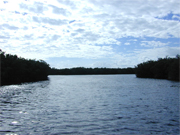Understanding and Predicting Global Climate Change Impacts on the Vegetation and Fauna of Mangrove Forested Wetlands in Florida
|
Project Investigators:
Thomas J. Smith III, Carole C. McIvor
Project Personnel: Noah Silverman, Katie Kuss, Christa Walker, Kevin Whelan, Fara Ilami, Suzanne Chwala, Ann M. Foster, Gordon Anderson Project Start Date: 1998 End Date: 2003 |
| Summary |
| The objective of the project is to address several key hypothesis related to global change impacts on the flora and fauna of the mangrove forested ecosystems which occur at the downstream end of the greater Everglades. |
Please note - this is a completed project.
| For more information, please visit the USGS Global Change Research in Biology and TIME websites, and the Tides and Inflows in the Mangrove Ecotone (TIME) Model Development Project Webpage. |
Mangrove forests dominate the intertidal zone of the world's tropical and subtropical low energy coastlines. Mangroves provide a variety of "ecosystem services" such as shoreline protection, food and fuel, and trophic support for commercial and recreational fisheries. In Florida and elsewhere, mangrove forests have been subjected to a variety of natural and anthropogenic stresses. As the greater Everglades ecosystem undergoes one of the most daring restoration projects ever undertaken, knowledge of the system's response to upstream water management and how this interacts with global change events such as rising sea level is entirely lacking. Sea level in south Florida is rising at measurable and unprecedented rates.
This project is addressing several key hypothesis related to global change impacts on the flora and fauna of the mangrove forested ecosystems which occur at the downstream end of the greater Everglades: 1) Mangroves in a geomorphic setting with relatively more edge (open-water/mangrove interface) support greater fishery productivity as measured by density and biomass/area than comparable mangroves with relatively little edge; 2) fishery productivity along upstream ecotones is positively related to net primary productivity of both mangrove and marsh ecosystems and to flooding duration, and inversely related to temporal variability in water-column salinity; 3) fires along the mangrove-marsh ecotone promote invasion of mangroves into adjacent marshes; and, 4) shifts in the position of the mangrove-marsh ecotone are linked to the passage of major tropical storms and hurricanes.
Work Plans
Project Summaries
Metadata
- Understanding and Predicting Global Climate Change Impacts on the Vegetation and Fauna of Mangrove Forested Wetlands in Florida (project metadata)
Publications
Abstracts
- Hydraulic Conductivity of Riparian Mangrove Forest Peat Adjacent to the Harney River, Everglades National Park: A Comparative Field Study of Field Saturated and Saturated Hydraulic Conductivity Methods (from the 2002 AGU Spring Meeting)
- Long-Term Data from the USGS/BRD Mangrove Hydrology Sampling Network in Everglades National Park (from the GEER Conference, April 2003)
- Short-Term Dynamics of Vegetation Change Across a Mangrove-Marsh Ecotone in the Southwest Coastal Everglades: Storms, Sea-Level, Fire, and Freeze (from the GEER Conference, April 2003)
Bibliographies
Fact Sheets
- Development of a Long-term Sampling Network to Monitor Restoration Success in the Southwest Coastal Everglades: Vegetation, Hydrology, and Sediments (FS-2004-3015)
- Lightning Gaps in the Mangrove Forest of Everglades National Park (FS-2004-3016)
Flyers
- Studies Supporting Restoration of Mangrove Habitat in Everglades National Park: Faunal Component (available from the Center for Aquatic Resource Studies website. Please note that this is a (0.2 Mb) PDF file and requires the FREE Adobe Acrobat Reader® to be read)
Papers
- Stable Isotope Studies of Red Mangroves and Filter Feeders from the Shark River Estuary, Florida (From the Bulletin of Marine Science: Vol. 70, No. 3, pp. 871-890; available from APT Online)
Posters
- Assessing the Consequence of Hurricane-Induced Conversion of Mangroves to Mudflats on Fish and Decapod Crustacean Assemblages in the Big Sable Creek Complex of Southwest Florida
- Characteristics of Lightning Gaps in the Mangrove Forests of Everglades National Park
- Consequences of Fire and Freeze on a Mangrove-Marsh Ecotone (http://sofia.er.usgs.gov/publications/posters/firefreeze/)
- Long-Term Data from the USGS-BRD Mangrove Hydrology Sampling Network in Everglades National Park (from the GEER conference, April 2003)
- Short Term Dynamics of Vegetation Change Across a Mangrove-Marsh Ecotone in the South-west Coastal Everglades: Storms, Sea-level, Fire and Freeze (from the GEER conference, April 2003)
Reports
- Understanding and predicting global climate change impacts on the vegetation and fauna of mangrove forested ecosystems in Florida (Final Project Report)

